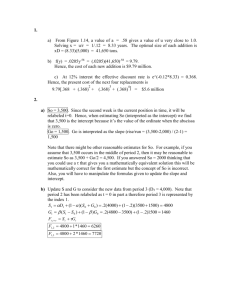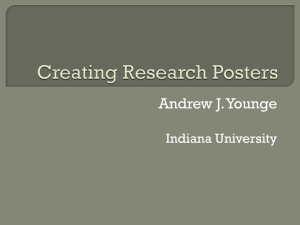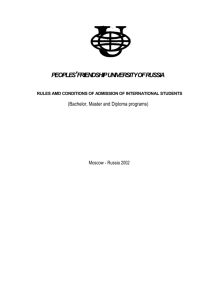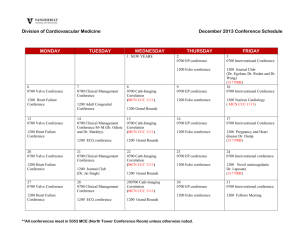JShield: Towards Real-time and Vulnerability-based
advertisement
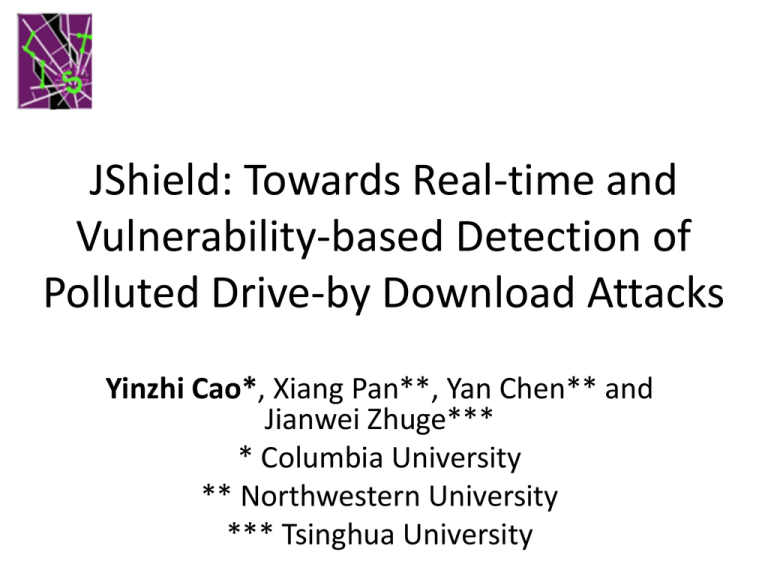
JShield: Towards Real-time and
Vulnerability-based Detection of
Polluted Drive-by Download Attacks
Yinzhi Cao*, Xiang Pan**, Yan Chen** and
Jianwei Zhuge***
* Columbia University
** Northwestern University
*** Tsinghua University
Outline
•
•
•
•
•
Introduction, Background and Overview
Motivation
Design
Evaluation
Conclusion
2/24
Introduction and Background
• Drive-by download Attack
– Unintended download of malicious computer
software from the Internet, which is usually due to
a browser vulnerability, such as buffer and heap
overflow.
• Approximately 1.3% of the incoming search
queries (millions per day) to Google returned
at least one URL with a drive-by download
attack.
3/24
4/24
Overview
• A reactive vulnerability-based approach to match
malicious JavaScript samples targeting drive-by download
attacks.
• JShield (> 4,000 additional lines of code integrated into
WebKit) has been adopted by Huawei, the world’s largest
telecommunication equipment maker.
• I spent two months at Huawei in 2012 and 2013
respectively to help them test JShield with millions of
real-world samples.
• JShield is filed under a U.S. patent (14/207,665).
5/24
Deployment
• Server Side
– The Web Application Firewalls (WAF) or Web
IDS/IPS
– Web malware scanning services
• Client Side
– Part of Anti-virus Software
6/24
Outline
•
•
•
•
•
Introduction, Background and Overview
Motivation
Design
Evaluation
Conclusion
7/24
Motivation
• Attackers will change existing malicious
JavaScript code to evade detection, called
sample pollution:
– Embedded inside DOM events, such as mouse
moves.
– Injected and interleaved with benign JavaScript
code.
8/24
Motivation Cont’d
Top Vendors in Industry:
Anti-virus Software
Original Samples
Polluted Samples
Avira Antivirus Premium 2013
98.00% (1176/1200)
0.58% (7/1200)
AVG Internet Security 2013
89.33% (1072/1200)
3.58% (43/1200)
Kaspersky Internet Security
2012
92.41% (1109/1200)
2.00% (24/1200)
Norton Internet Security
2013
20.67% (248/1200)
0.08% (1/1200)
Trend Micro Titanium Internet
Security 2013
87.58% (1051/1200)
2.00% (24/1200)
9/24
Motivation Cont’d
State-of-the-art Research Work:
Detection Rate of Zozzle [1]
Original Samples
Polluted Samples
True Positive
93.1%
36.7%
False Positive
0.5%
0.5%
[1] Curtsinger, Charlie, Benjamin Livshits, Benjamin G. Zorn, and Christian
Seifert. "ZOZZLE: Fast and Precise In-Browser JavaScript Malware Detection."
In USENIX Security Symposium, pp. 33-48. 2011.
10/24
Outline
•
•
•
•
•
Introduction, Background and Overview
Motivation
Design
Evaluation
Conclusion
11/24
Accuracy
High
Solution Space
Turing
Machine
Signature
JShield
Signature
Ideal
Signature
Symbolic
Constraint
Signature
Regular
Expression
Speed
High
12/24
System Architecture
13/24
Opcode Signature Example
Clause
Sentence
Signature
14/24
Example
Exploit:
var obj = new Object();
obj.__proto__.__defineGetter__("a", function () {
this.__proto__ = null;
return 0;
});
obj.a;
Outputted Opcodes:
15/24
Matching Process
Opcodes of the exploit:
Signature to be matched:
State 3
1
2
16/24
Outline
•
•
•
•
•
Introduction, Background and Overview
Motivation
Design
Evaluation
Conclusion
17/24
Evaluation
• Vulnerability Coverage Rate
• Robust to Sample Pollution
• Performance
18/24
Evaluation
Vulnerability Coverage
Vulnerability
Position
BrowserShield
Song et al.
JShield
JS Engine
3/22
0/22
22/22
PDF JS Engine
4/18
0/18
18/18
Plug-in
20/21
21/21
21/21
Reis et al., Browsershield: vulnerability-driven filtering of dynamic html. In OSDI (2006).
Song et al., preventing drive-by download via inter-module communication monitoring. In
ASIACCS (2010).
19/24
Evaluation
Accuracy
Original Samples
Polluted Samples
TP for Web Pages
100%
100%
FP for Web Pages
0%
0%
Anti-virus Software
Original Samples
Polluted Samples
Avira Antivirus Premium 2013
98.00% (1176/1200)
0.58% (7/1200)
AVG
Internet Security 2013
Zozzle
Kaspersky
Internet Security
True Positive
2012
False Positive
Norton Internet Security
2013
89.33%
(1072/1200)
Original
Samples
92.41%93.1%
(1109/1200)
Trend Micro Titanium Internet
Security 2013
3.58% (43/1200)
Polluted
Samples
2.00% (24/1200)
36.7%
0.5%
20.67% (248/1200)
0.5%
0.08% (1/1200)
87.58% (1051/1200)
2.00% (24/1200)
20/24
Evaluation
Performance
21/24
Outline
•
•
•
•
•
Introduction, Background and Overview
Motivation
Design
Evaluation
Conclusion
22/24
Conclusion
• In this talk, I presented JShield, a vulnerability
based detection engine of drive-by download
attacks.
• JShield represents the semantics of each
vulnerability and is robust to sample pollution.
• In evaluation, we show that JShield incurs
affordable overhead.
23/24
Thank you!
Questions?
yzcao@cs.columbia.edu
http://www.yinzhicao.org
24/24




